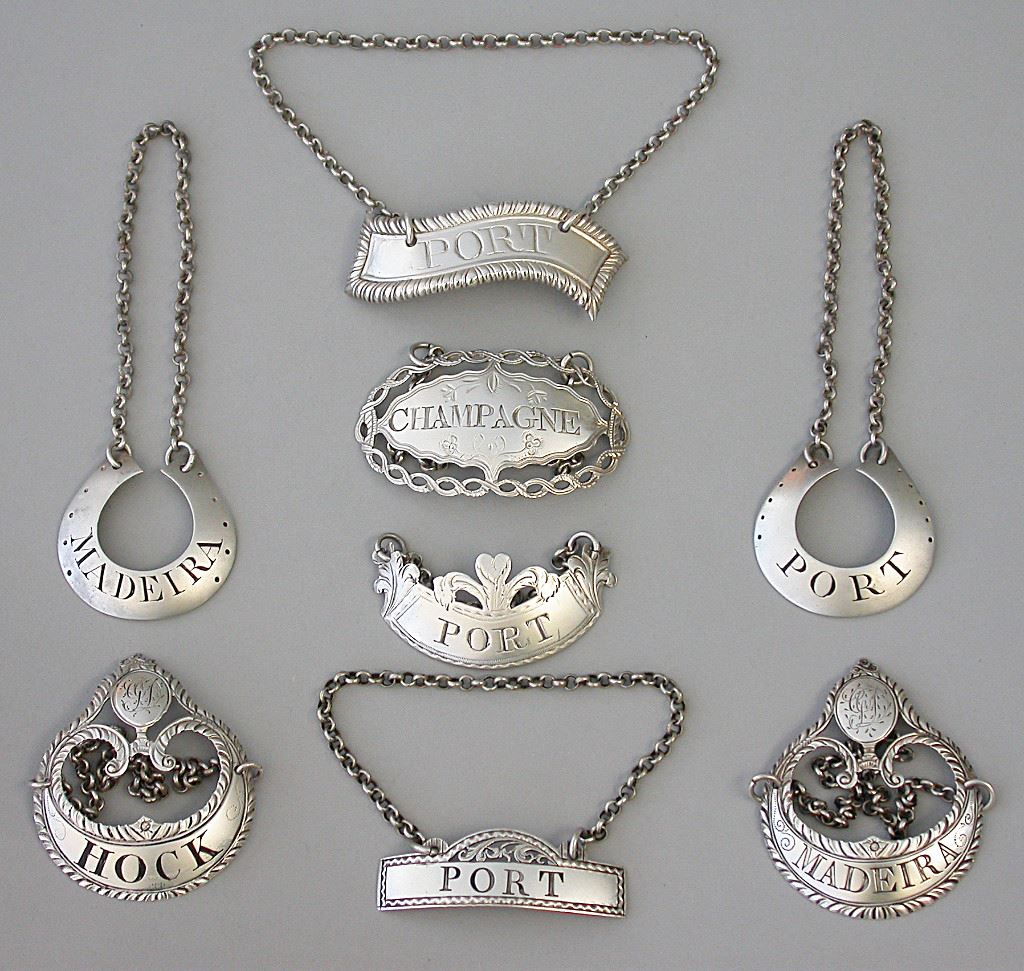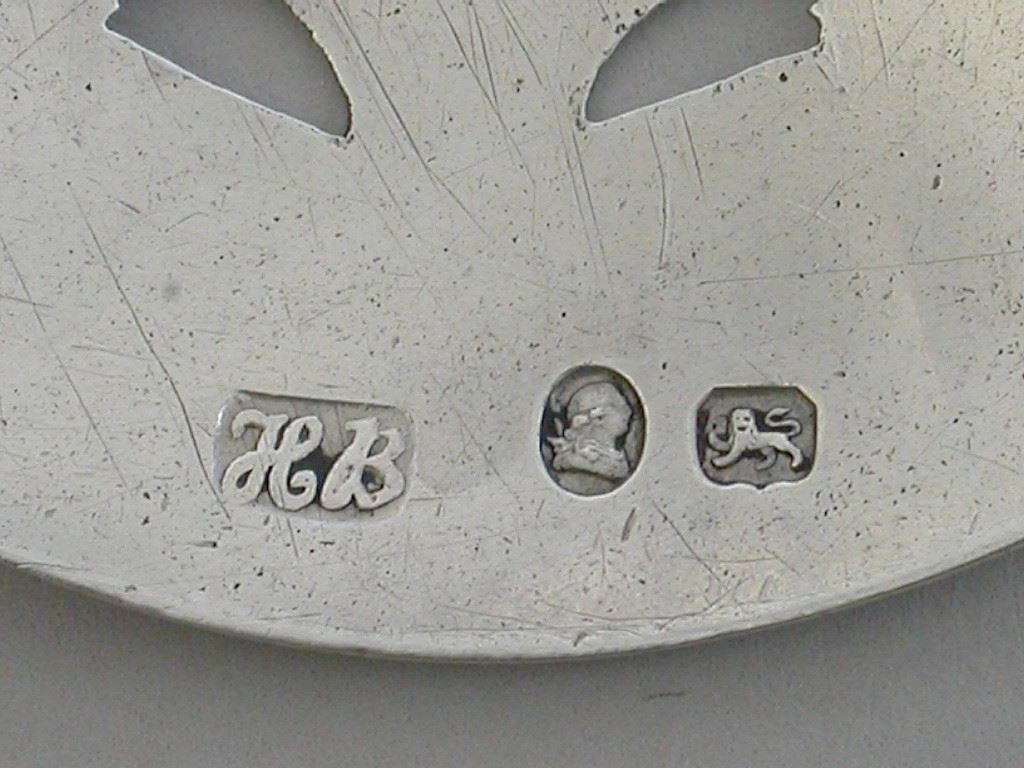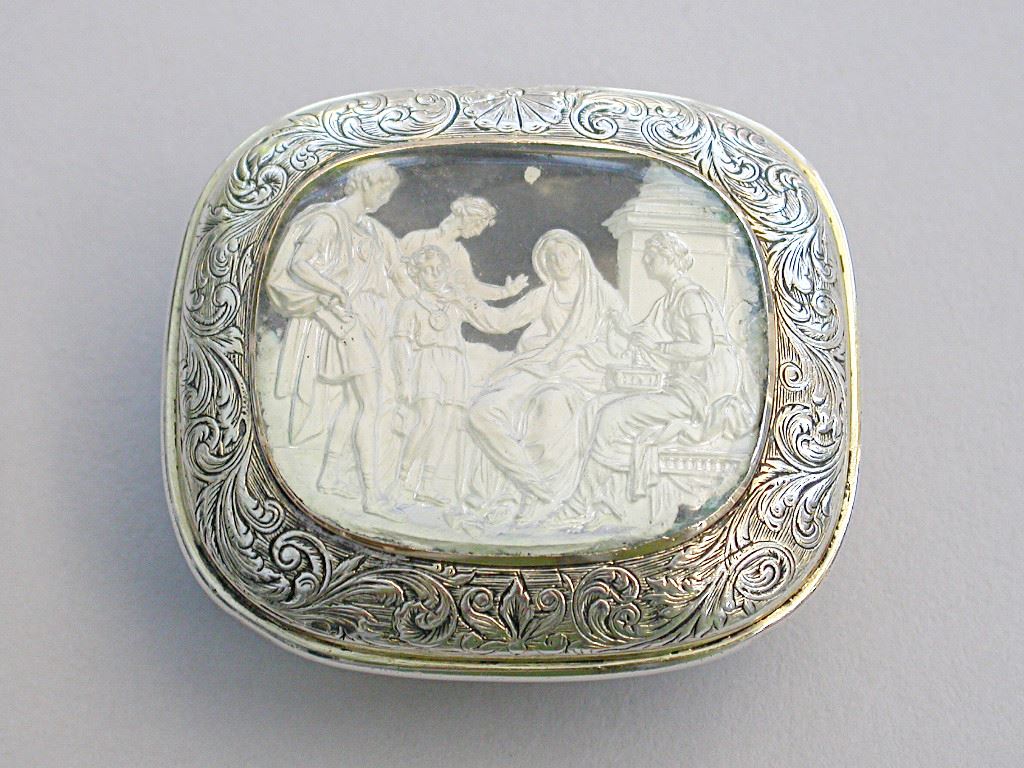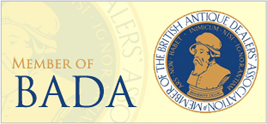|
Steppes Hill Farm Antiques Newsletter # 73 - September 2017
|
 |
"Silver Wine Labels by Hester Bateman"

(please click on the image above to zoom)
Hester Bateman 1761-1790 Bunhill Row, London EC 1
“The Queen of English Silversmiths noted for designs of neo-classical elegance”
In 1761, when Hester Bateman entered her first mark, she was the widow of a chainmaker, John Bateman, whom she married at St Botolph’s, Aldersgate, on 20th May 1732. By 1790, when she retired, her firm was one of the largest manufacturers of silver in London. One of the reasons for this phenomenal success is that the Batemans were quick to exploit the rapid advances in technology that were developing at the time. Also, and perhaps no less important, they had an innate appreciation of the aesthetics of the fashionable neo-classical or Adam style.
 The Bateman workshop was among the first in London to install a steam engine and flatting mill, and from the evidence of their work, this must have taken place about 1770. The quantity of surviving pieces and the frequency of their mark found overstruck by that of another silversmith or retailer makes it obvious that they were suppliers to the trade. Their work is almost always of light-gauge and simple, if pleasing in design – as would be expected of one of the most commercially successful ‘factories’ of the period. The characteristic bright-cut engraving found on their pieces, attractive though it undoubtedly is, represents a far more labour efficient method of decoration than the cast, chased and finely engraved methods that preceded it.
The Bateman workshop was among the first in London to install a steam engine and flatting mill, and from the evidence of their work, this must have taken place about 1770. The quantity of surviving pieces and the frequency of their mark found overstruck by that of another silversmith or retailer makes it obvious that they were suppliers to the trade. Their work is almost always of light-gauge and simple, if pleasing in design – as would be expected of one of the most commercially successful ‘factories’ of the period. The characteristic bright-cut engraving found on their pieces, attractive though it undoubtedly is, represents a far more labour efficient method of decoration than the cast, chased and finely engraved methods that preceded it.
It is unlikely that Hester Bateman ever made anything with her own hands. She would not have served an apprenticeship. However, her eldest son Peter had completed his apprenticeship in 1761 when Hester took control of the business, and Jonathan, her younger son, completed his in 1769. It is probably these two, therefore, who were responsible for the actual making, aided by a gradually increasing staff of hired workmen, while Hester concentrated on the management.
Hester Bateman Wine Labels can be divided into two stylistic periods: the early years 1761-1770 and the much more prolific neo-classical inspired years 1770-1790. For the first few years (prior to mechanisation) fairly standard shapes such as escutcheons (actually quite rare by HB) and rectangles, crescents and scrolls were produced, most often with “feathered-edge borders”. (See: pair of horseshoe shaped labels above for PORT & MADEIRA).
Whilst great originality had been shown in the first decade, it was in the neo-classical period that Hester really flowered and, in the relatively minor field of Wine Labels, became the leading producer of beautifully designed and superbly crafted work. Ovals, goblets and festooned drapery were added to the repertoire of shapes. Borders were bright-cut as often as gadrooned, rather rarely beaded and, most pleasing of all, sometimes pierced with entwined cables (see: CHAMPAGNE above), zig-zags or foliate garlands. An oval cartouche for the engraving of a crest or monogram was also a distinctive addition at this time (see: HOCK & MADEIRA above).
A very distinctive and often copied design of the later years, not often seen by Hester, but more usually by Peter, Ann or William Bateman is the “Prince of Wales Feathers” featuring a plume of three ostrich feathers above a bright-cut curved narrow rectangle with engraved foliate feathered ends (see: PORT above (by Hester) and pair for W*WINE & RED PORT (by Peter & Ann) on SHFA web site).
Hester must have retired before 7th December 1790, when her sons Peter & Jonathan entered their mark. Jonathan died on 17th April 1791, making labels bearing the mark of Peter & Jonathan particularly rare (see; W:WINE on SHFA web site).
Hester Bateman, with her thirty years of female control at a time when the fashion was
becoming delicate, has gained a mysticism beyond any of her rivals. While there are
varying opinions about the quality of the output of her workshop she should be
celebrated as a pioneer in the mechanisation of the silversmithing trade, rather than
mourned as the last of the English craftsperson’s. It is of considerable interest that Hester Bateman's work was very popular in her own time though it is also now considered by some experts to be overvalued by the public. I would think that the reason for the appeal is in the aesthetic appeal of the restrained and elegant style which was deemed attractive by the aspirant middle class of Hester Bateman's own time and continues to strike a chord with the buyers of today.

Featured Item

Cornelia, Mother of the Gracchi
Cornelia, the Mother of the Gracchi, was a real woman who lived in Rome during the 1st Century B.C.E. She was admired during her life, and for centuries after (right up until the Victorian era), as the perfect example of Roman motherhood.
Perhaps no woman better represented the paradigm of the ideal Roman matrona (wife) than Cornelia, forever known as “mother of the Gracchi.” Born in the late Republic, in her own and later times she was held up as a supreme example of Roman feminine virtues by men and women. True to the low profile for which she was universally admired, no statue has survived of the mother of the Gracchi (although a famous one was set up in Rome after her death, perhaps the first statue of a non-legendary woman).
Cornelia was the daughter of legendary warrior-hero Publius Scipio Africanus (who defeated Hannibal in the second Punic War). Both the dates of her birth and death can only be inferred. She married well (to patrician cousin Tiberius Sempronius Gracchus) and bore him twelve children. Only three lived to adulthood: a daughter, Sempronia, and two sons, Tiberius and Gaius Gracchus.
After her husband’s death, Cornelia devoted herself to raising her three young children in the highest patrician traditions of service to the state. Allegedly, soon after her husband left her a young widow, the Egyptian king Ptolemy VIII proposed marriage and she refused him, thus embodying the Roman ideal of the univira, a widow who survives her first husband and loyally never remarries.
At a time when Rome’s increasing overseas empire meant a flood of wealth and ostentatious display, Cornelia was said to have lived with modesty and thrift. A legend preserved by Valerius Maximus claims that, when another woman who was a guest in her house “…showed her jewellery, the finest in existence at that period, Cornelia kept her in talk until her children came home from school, and then said ‘These are my jewels.'” (See print above).
Her influence on both her sons was considerable even after their political careers made them the lightning rods of reform in the late Republic. She would survive the tragedy of losing first her eldest, then her youngest, son to political murder.
In other words, Cornelia’s story demonstrates that, during historical times when “gently born” women were not allowed to leave the home and work at paying jobs of their choice, their default role as mother was itself elevated to a career, with honours and acclaim going to those who did well after this lifetime role was thrust upon them.

 |
 |

I do hope that you will find this Newsletter informative and helpful and will allow us send it to you on a regular basis. I would welcome any feedback you may have, both positive and negative.
David W.A. Buck.
Steppes Hill Farm Antiques |
|





